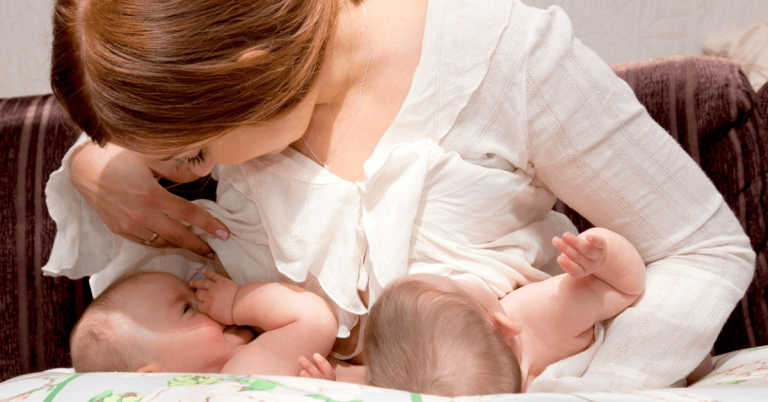Congratulations, your little one just turned two! He blew out two candles and is now running around the house laughing. He continues to surprise you every day with the skills he has developed. Many of his moves are now so perfect that you wonder how it is possible that all this happened in such a short time! Knowing what to expect will help you support your baby’s development and ensure that the moments you spend together turn into unforgettable memories. This article will help you with this.
Measurements at 24 Months
Avoid comparing the length and weight of your child with those of other children. Your baby’s height and weight depend on factors such as nutrition, environment, illness, level of activity, etc. A twenty-four-month-old may even experience some weight loss because he is very active. Studies have also shown that genetics, the genes passed on from the parents to their children, also play a very important role.
Nevertheless, a baby’s weight and length must stay within the World Health Organization (WHO) limit values. You should regularly follow up on your baby’s physical development with your family doctor or paediatrician. If his measurements diverge greatly from the standard, you should consult a specialist because this may indicate other health problems and impact your baby’s overall development. The table below shows the value ranges for a twenty-four-month-old child in terms of weight, height, and head circumference.
| Gender | Length | Weight | Head Circumference |
| Girl | 80 cm – 92 cm | 10 kg – 15 kg | 44 cm – 50 cm |
| Boy | 82 cm – 93 cm | 10.5 kg – 15.5 kg | 46 cm – 51 cm |
Cognitive Development
- Discovery time! Imagine: You have bought a new toy for your child. Immediately, his tiny hands start to explore the toy. I wonder what he’s doing… Of course, the power button! This behaviour is indicative of the level of your child’s cognitive, intelligence, and fine motor skills development. Your baby knows to look for a switch and how to use his hand and wrist muscles to power it.
- At the age of two, children want to act like adults, and at the same time, they behave like little explorers. They will closely observe their environment and want to touch every object they see. And they will show a strong desire for freedom and autonomy. For example, when you try to get your baby dressed or want to feed him, he will insist on doing it himself. As long as your child is safe, allowing him to enjoy his freedom contributes to his cognitive development.
- Your little one can distinguish and point out three to five colours when you ask. Repeatedly point out the colours of common household objects and toys to help him learn.
- Your baby will now dress his doll or plush toy correctly, putting the pants over the legs instead of on its head. But you will have to wait a little longer before he can get dressed on his own.
- When asked, he can show the location of at least six body parts and say their name. You can help him by singing fun songs.
- He perceives the concept of “one” and can apply it when you say, for instance, “Can you give me one of those balls, please?” Make sure to use adjectives in your sentences. This will help your child to learn concepts such as “beautiful,” “large,” “small,” “tasty,” ….
- Your toddler can understand prepositions such as “in” and “on.” When asking for an item, use sentences like, “Can you bring me the ball on the table?” instead of “Can you bring me the ball?” This will help him understand these concepts.
Language Development
As you may have guessed, language and cognitive development are closely intertwined. Your child first learns to understand the world and then to put his experiences into words. So parallel to your baby’s cognitive development, there will be a great increase in his vocabulary.
- At twenty-four months, your child will overwhelm you by constantly asking, “what is this?” This is not to annoy you, but because he is always learning new words. Try not try to gloss over or ignore those questions. Answering them helps him increase his vocabulary. And anyway, he will not leave you alone until you answer. 😊
- You now have a little friend to chat with. He understands many of the words you say and can express his wishes using 100-120 words and short, simple sentences of three words. You can support his fluency by having more complex conversations on topics that interest him.
- Your toddler understands “who,” “where”, and other frequently-used question words and gives the correct answer. Colourful story books are your best friend in helping your little one learn these concepts. You can contribute to his language development by asking questions about the characters in the book, such as “Where is the dog?” or “Who went to the forest?”
- Your little one will probably love to sing. Especially nursery rhymes and songs about animals make him very happy. Don’t forget to record your little one’s singing on audio and video!
Physical Development
- You no longer need to worry about your house falling apart! Your baby, who specialises in creating chaos, now also starts to succeed in cleaning up his mess. Practice this regularly by modelling and explaining what you do. Besides leading to a cleaner house, picking up toys also supports his psychomotor development. What do you want more?!
- It is finally time to introduce your little one to play dough! Your little one has now developed enough hand-eye coordination to enjoy it, and the safety concerns, such as exploring everything with his mouth, have diminished. Play dough is very versatile. You can create recognisable shapes and roll, knead, and cut. You can experiment with giving your child a pair of toddler scissors with a blunt tip. He can cook some delicious meals by cutting pieces of play dough and putting them in a cooking pot. Kneading the dough helps his little hands get stronger and provides a lot of the sensory stimulation a toddler needs.
- You can help your twenty-four-month-old baby’s fine motor development by letting him string objects with a hole onto a thick thread. With this activity, you can also create wristbands and bracelets which you can give as a present to family and friends.
- Your child may love climbing up and down the stairs on his own. Some children can use both feet alternatingly, while others will go up and down, leading with one foot. However, stairs are a well-known source of accidents at home. Therefore, installing a safety gate at the top and bottom of the stairs is important.
- Children of all ages enjoy playing with balls. Your little one’s gross motor skills develop very quickly, and he has started to master playing with a ball. He can kick it with his feet and throw it with his hands. You can support this by giving him a colourful, age-appropriate ball to play with.
- Your baby is now not only running but has also started to jump. This soon becomes one of his favourite activities. Enjoy his bubbly smiles and join the fun by holding his hands. Taking your child to an indoor play area with trampolines can be a great way to spend an afternoon out.
Social-Emotional Development and Self-Care
- A twenty-four-month-old baby is very sociable. He now starts to establish relationships with other people around him.
- You should not expect him to communicate much with his peers just yet, because they are like rivals to him. If his toy has been taken away from him or he has been hurt, he will not forget this easily and may not want to play with his peers for a while. Be patient and support him to get through this period without forcing him.
- Your little one wants to declare his independence and may no longer wish to hold your hand while walking on the street. Beware of this! While you are looking in a different direction for a second, he may suddenly drop your hand and disappear into the crowd.
- Your little one can now brush his teeth, wash his hands, and put on some of his clothes.
- One of the most important developmental features around this time is that your little one is getting ready for toilet training. This is a very important process for his emotional and social development in the future. Don’t start this before your baby is physically and psychologically ready. Forcing your baby may cause big issues later on.
Play at 24 Months

Play dough is wonderfully versatile and helps children develop fine motor skills. You can hide small toys inside or make animal prints on them. Your baby can knead, roll and cut it. He can pretend to cook delicious meals, bake a cake or scare you with his snake. You can buy play dough in the store or prepare it yourself at home. Here is a nice and easy recipe for you!
Ingredients:
- 2 tablespoons of oil
- 2 tablespoons of vinegar
- ½ cup of water
- ½ cup of flour
- ½ cup of salt
- Food colouring
Preparation:
- Mix the water, oil, salt, and food colouring in a cooking pot and bring to a boil. Just before the mixture starts to boil, slowly mix in the flour. Once the dough begins to form, turn off the heat and leave to cool down. Make sure the dough has cooled completely before playing with it. Have fun! You can store the dough in a closed container for a while. For hygienic reasons, discard it after playing with it 5 to 6 times.
- Place two differently coloured bowls in front of your child. Mix clothes pegs in the colours of the two bowls in another box. Show your little one how to sort the pegs in the correct bowl according to their colour, and encourage him to follow your example.
- Buy a large piece of paper, at least the length and width of your child. Place it on the floor and ask your child to lie on the sheet. Then draw around your kid’s body with a pencil. If he doesn’t want to lie down, you can also place some clothes on the floor and draw around them. Then put some of his clothes in a basket and ask your child to place them on the picture in the appropriate location. After a while, deliberately misplace the clothes and give your little one the chance to fix your “mistake.” You can also do this activity by drawing your own body. The game will be even more fun if you add an enlarged photo of your or your child’s face to the picture.
- Fasten large sheets of paper to the wall or a closet. Draw shapes of different sizes and encourage your little one to paint or colour them. You can include all family members in this activity and create beautiful memories together.
- Your baby, who has just turned two, has reached the level of mental development to play symbolic games. A magical activity is to create a puppet show for your toddler. He will love it! Using your imagination, you can make puppets with materials such as socks, yarn, cotton, and wiggle eyes, use a cardboard box to hide behind and let the puppets talk in different voices.
Nutrition at 24 Months
For your child’s healthy development and growth, balanced meals are crucial. This means he needs to consume something from all food groups daily. Continue to serve three main meals plus light snacks. Make sure the snacks don’t fill up your little one’s stomach. Otherwise, he will be reluctant to sit with you at the family table for his main meals.
Your little one’s desire for independence also manifests itself when eating. He may get angry when you try to help him eat. Instead, create the circumstances for him to eat on his own, and allow him to choose which of the foods you offer he wants to eat and when he is full. This will prevent eating disorders in the future.
You can use the Eatwell Guide to create your child’s menu (from two years onwards). A large part of the Eatwell Plate is filled with vegetables, fruits, and starchy carbohydrates. This is supplemented with proteins like fish, meat, beans, and pulses and dairy or non-dairy alternatives. The use of oils and fats is recommended in small amounts. Sweets, fast food, and snacks fall outside the Eatwell Plate, and it is recommended to eat them only occasionally and in small quantities. You can find the up-to-date guide here: https://www.bda.uk.com/uploads/assets/6d2d239a-9bfc-4ac2-b679771e5c653d1c/Healthy-Eating-food-fact-sheet.pdf
Sleep at 24 Months
If your child has trouble falling asleep, you can read to him or sing soft lullabies. Also, at this age, babies tend to wake up frequently because they sleep very light. If your kiddo is not crying, you can wait for him to fall asleep on his own again.
Every baby’s sleep needs differ. On average, a twenty-four-month-old baby sleeps 11 hours at night and 1.5−2 hours during the day. If your little one has trouble sleeping at night, you may try reducing daytime naps.
As babies learn through imitation, try to be conscious of your attitudes and behaviours. They impact your baby’s health and happiness. Knowing what the average development of a twenty-four-month-old baby looks like will help you monitor and support your baby’s growth. And most importantly, show your kid lots of respect and love.
Shopping Advice – What to Buy?
A play dough set is perfect for your kiddo’s second birthday. You should also add other arts and craft materials like finger paint, jumbo crayons and large sheets of paper to your child’s creativity corner. And what about buying a set of puppets to create a magical puppet show? Twenty-four-month-old babies also love books about shapes and colours. And to help pique your little one’s interest in potty training, the time is ripe to buy a potty and toilet seat adapter and to read books about going potty. You can look at ebebek.com, read other parents’ comments, and buy them at affordable prices.
It’s Your Turn Now – Write a Comment!
How are you raising your twenty-four-month-old baby? What challenges did you experience? How did you overcome them? We welcome your comments so that other caregivers can learn.
Don’t Forget to Share!
Don’t forget to share our twenty-four-month-old baby development article so that expectant parents and other caregivers can read and learn!







